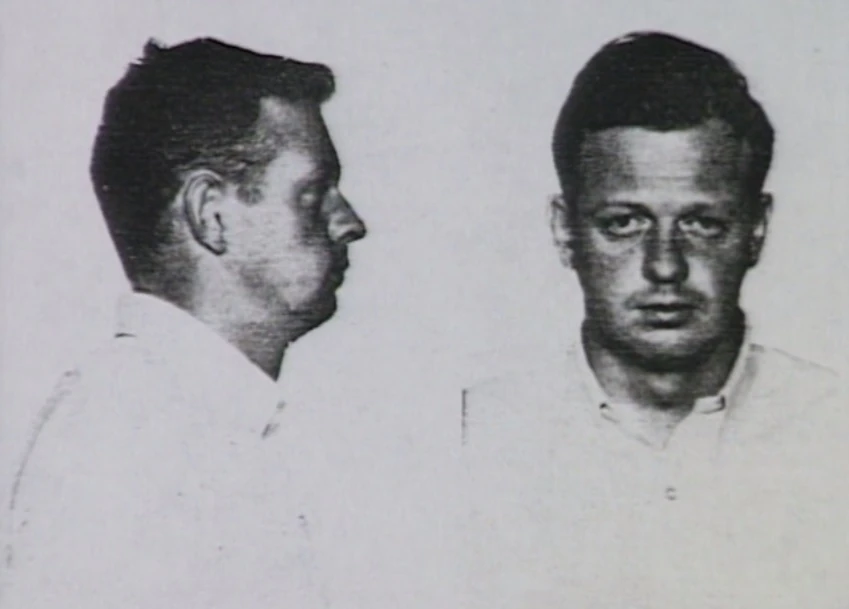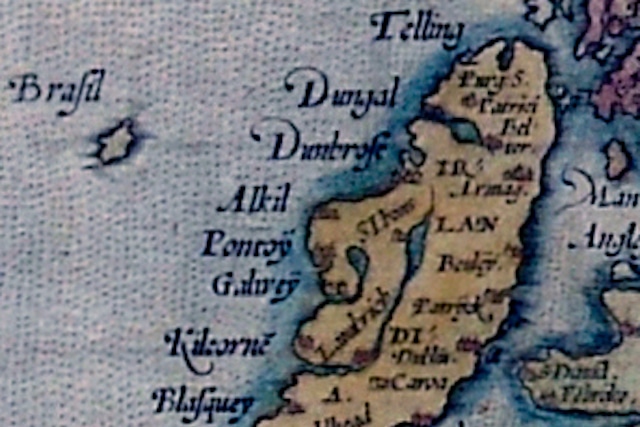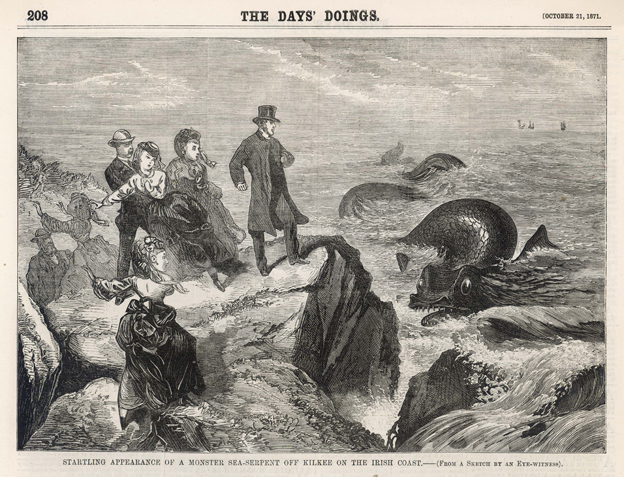The United States, Canada, Australia, and Scotland. We’ve explored some of the greatest mysteries from all of these lands, and today we are adding Ireland to the list.
We’ll be looking at unsolved murders, an island that only appears once every seven years, sightings of a bewildering sea monster, and unexplained disappearances of people, jewels, and one horse.
8. Have You Seen Joe Maloney?

Bizarrely enough, we are starting off this list on Irish mysteries in the United States of America. In 1967, Joe and June Maloney of Rochester, New York, went through a bad breakup after the wife got tired of her husband’s physical and mental abuse. Joe Maloney’s response to his wife leaving him was to poison her, which he did at their son’s fifth birthday.
Maloney was hardly a master criminal, and his behavior and his insistence that his wife committed suicide immediately raised the suspicions of the police. An autopsy revealed the poison and Joe Maloney was subsequently arrested and convicted. However, instead of prison, he was temporarily sent to Rochester State Mental Hospital, while awaiting a psychiatric examination. Unbeknownst to the authorities, Maloney used to work there as a janitor, and knew the layout quite well. Just a few weeks later, he escaped and disappeared.
We travel now to Ireland, five years later, in the city of Dublin. Irish police were at the house of a local bartender named Michael O’Shea, who had just been burgled. As a routine procedure, they took O’Shea’s fingerprints, so they could tell which ones belonged to him and which ones belonged to the burglar. They were very surprised to discover that their bartender’s prints matched those on an FBI wanted poster for Joe Maloney.
In the years that had passed, Maloney started a new life in Ireland and even remarried. Unfortunately, there wasn’t much the Irish police could do, since there was no extradition agreement between the US and Ireland at the time. It came much later in 1984, and O’Shea was arrested again, with the intent of sending him to America. However, the treaty fell through in 1986, and Maloney found himself a free man once more. He then disappeared again and has not been seen since.
7. The Missing Postman
It was Christmas Day in 1929, in the village of Kilmacthomas in County Waterford, Ireland. Larry Griffin, the local postman, got on his bike and went to make his deliveries, starting in the nearby village of Stradbally. Back then, it was customary to offer the postman a drink, as thanks for working on Christmas, so when Griffin did not turn up later that day, it was assumed that he had indulged in too much “Christmas cheer” and was sleeping it off somewhere. Only when someone found his bike abandoned by the side of the road did people realize that something more insidious had happened.
The disappearance of the postman became a big case in Ireland. It was, in fact, one of the first big cases handled by the Gardai, Ireland’s national police service, which had only been around for a few years at that point. It turned into a much bigger scandal when two of its own officers were implicated in the affair.
Here is the most common version of the story, which has been widely circulated, although there is no hard proof to back it up. Larry Griffin did, indeed, get drunk in Stradbally, and went to the local watering hole called Whelan’s Pub. There, he got into a fight with a local and, during the drunken brawl, Griffin fell, hit his head and died. Everyone else in the pub, including two Gardai officers, then conspired to hide the crime and get rid of his body.
Ten people were arrested and charged with various crimes, including murder, obstruction, and conspiring to dispose of a dead body. The prosecution’s case mainly rested on a local witness named James Fitzgerald, but when he took the stand, his story differed from the written statement he had given to the police. Eventually, the prosecution was forced to drop all charges and the ten defendants walked free.
There are three plausible reasons why Fitzgerald did this. First, his original statement was a lie and was coerced by the police. Second, his original statement was true, but he was then coerced by the villagers to lie on the stand. And third, he knew the death was an accident, and he didn’t want anyone convicted of murder which would have been a death sentence. As for the missing postman, his ultimate fate remains a mystery.
6. The Phantom Island

If you explore the Atlantic Ocean west of Ireland, you might find a very small island generally known by the name Hy-Brasil. At least, you should find it. After all, it has been shown on maps for over 500 years, including on those made by renowned cartographers such as Mercator or Ortelius. But this tiny island is, in fact, a product of myth and mystery much like the famed lost city of Atlantis.
The first known mention of this phantom land comes from 1325, in a nautical chart made by cartographer Angelino Dulcert where he identifies the Island of Bracile near Ireland. Later, a map made by Andrea Bianco in 1436 also named the Insula de Brasil. With each repeated mention, the existence of this island became more of a fact, and just a few decades later people started setting off in search of it. Some even claimed to have found it, such as the Irish Saint Brendan of Clonfert and the Italian explorer John Cabot. Perhaps its most famous visitor was the Scottish Captain John Nisbet, who allegedly found the island while sailing through a heavy fog.
Over the centuries, others have claimed to have seen the island appear and then vanish in front of their eyes. It became known as the Enchanted Isle, with stories that it only appears once every seven years before disappearing again into the mists.
5. The Kilkee Sea Monster

Staying on the west coast of Ireland, we get closer to shore as we approach the small seaside town of Kilkee, in County Clare, which allegedly has its own giant sea monster similar to the creature in Loch Ness.
Unlike Nessie, this one does not have a catchy name, but it has been described in a Victorian newspaper as having “an enormous head, shaped somewhat like a horse, while behind the head and the neck was a huge mane of seaweed-looking hair which rose and fell with the motion of the water.”
It appears that several sightings of the Kilkee monster were reported during the 19th century. This included one appearance in 1850 when the beast appeared to be “sunning itself” and a more famous sighting in September, 1871, when the sea creature was spotted by a whole group of people, including a well-known clergyman, while they were out walking at a spot known as Diamond Rocks.
It was this last event that caused the story to be picked up by British and American newspapers, even including an illustration of how the monster supposedly looked. The same story also included an interview with pioneering marine biologist Philip Henry Gosse, who opined that the creature was an example of an ancient race of marine reptiles thought to be extinct known as Enaliosauria.
4. Who Was Peter Bergmann?
There is a famous mystery in Australia known as the Somerton Man or the Tamám Shud case, which refers to the body of a man found in 1948 on a beach, that remains unidentified to this day despite extensive international searches.
Ireland has its own version of the Somerton Man, although this one is more recent and has yet to attain the notoriety of its Australian counterpart. On the morning of June 16, 2009, a father and son running on the beach at Rosses Point found the body of a middle-aged man, with no money or form of identification on him. He was wearing Speedos and a t-shirt, and showed no obvious signs of foul play, so police initially suspected an accidental drowning. However, when trying to identify him, they soon discovered that the man went to great lengths in order to hide his true identity.
Thanks to records and security camera footage, Irish authorities were able to piece together the last few days of the mysterious man. He had arrived in Northern Ireland on June 12, and took a bus from Derry to the Irish coastal town of Sligo. He stayed at the Sligo City Hotel where he paid in cash. He gave an address in Vienna and used the name Peter Bergmann, although both turned out to be false.
At one point, camera footage showed him leaving the hotel with a plastic bag full of personal belongings, which he did not have when he returned. Presumably, he traveled around the city, getting rid of anything that could identify him, and police were unable to recover any useful items. His other activities were more mundane: he went on walks, he chatted with people, he went to a restaurant, he purchased some stamps, and he took a taxi ride where he asked the driver for the location of a nice, quiet beach.
His autopsy revealed that he was a very sick man, who had several tumors, advanced prostate cancer, and had suffered multiple heart attacks. His death was most likely a suicide, but the true mystery remains surrounding his identity and why he went to such great efforts to conceal it.
3. The Theft of the Crown Jewels

Ireland used to have its own Crown Jewels, consisting of a heavily-jeweled star and badge valued at around $20 million today. However, they have been stolen from Dublin Castle over 100 years ago, and what exactly happened to them remains one of the country’s greatest mysteries.
Despite their popular name, the so-called Irish Crown Jewels were not actually connected to the monarchy. Instead, they were linked to the Most Illustrious Order of St. Patrick, an order of chivalry created in 1783 by King George III to act as an Irish complement to the Order of the Garter in England and the Order of the Thistle in Scotland.
The theft of the jewels was discovered on July 6, 1907, alongside five collars that belonged to members of the order. Newspapers of the time proclaimed this as an impossible heist, writing that “there is no spot in Dublin, or possibly in the UK, which is at all hours of the 24 more constantly and systematically occupied by soldiers and policemen.”
However, upon closer inspection, it seemed that security was a bit more relaxed than expected. For starters, a strongroom had been built for the jewels back in 1903. However, only after it was finished did officials realize that the safe which housed the jewels was too big to fit through the door, so instead, it was kept in the library outside the strongroom.
The man in charge of protecting the jewels was the Ulster King of Arms, a position held in 1907 by Sir Arthur Vicars. Only he was supposed to keep the two keys which opened the safe, one on his person and the other one at home. However, there were rumors that Vicars wasn’t incredibly diligent when it came to safeguarding the keys, especially after an intense drinking session.
He was fired from his position and became an obvious suspect. Other suspects included his assistant, his second-in-command, and several other people working at Dublin Castle, since it was commonly believed that the heist was an inside job. That being said, nobody was ever arrested for the crime and the Irish Crown Jewels still remain missing.
2. The Vanishing Triangle
There is an area in Ireland where a lot of women have gone missing during the 1990s. It was dubbed the Vanishing Triangle by the media, and includes areas in and around Dublin.
Between 1993 and 1998, at least six women have gone missing, starting with Annie McCarrick, a 26-year-old American from New York who was visiting Ireland. Her disappearance led to one of the most extensive searches in the country’s history, but authorities found no trace of her. The same thing happened with five other young women who vanished over the following years.
Investigators now fear the worst and believe that the women fell victims to a serial killer. A convicted rapist named Larry Murphy emerged as a strong suspect, especially since the disappearances stopped around the same time that he went to prison. However, even with the assistance of the FBI, Irish police were unable to conclusively connect him to any of the vanishings. He has since been released from prison and his whereabouts are uncertain, and no other suspects have been named publicly.
1. The Disappearance of Shergar
Strangely, the most notorious disappearance in Irish history was not that of a human, but rather of a horse named Shergar. He wasn’t just any horse, though. When he went missing almost 40 years ago, Shergar was valued at over $15 million, making him the most prized horse in the world.
Born in County Kildare, he had been a champion racehorse. Owned by the Aga Khan IV, the two-year-old Shergar made his racing debut in the 1980 season, and then went on to dominate the 1981 season. Afterwards, the owner decided to put him out to stud, and began selling dozens of shares as people were paying over $120,000 for the opportunity of having their mares impregnated by the champ.
On February 8, 1983, a group of masked men armed with pistols and machine guns arrived at the Ballymany Stud where Shergar was kept. Some of them locked the people in a room at gunpoint while others loaded the animal into a horsebox. They said that they wanted £2 million in exchange for the horse’s safe return.
The world never saw Shergar again. Negotiations didn’t go well between the kidnappers and the syndicate that owned the horse. The latter were not satisfied with the proof of life sent by the former. They kept pushing for more, but this angered the kidnappers who, eventually, broke off all communications and never tried to make contact again.
Although never proven, it has been consistently believed that the kidnapping had been arranged by the Provisional Irish Republican Army, or IRA, as a quick money-making plot. An informant claimed that the IRA stole the horse, who then injured his leg in a fit of panic, and was then put down. Shergar’s remains were never found.